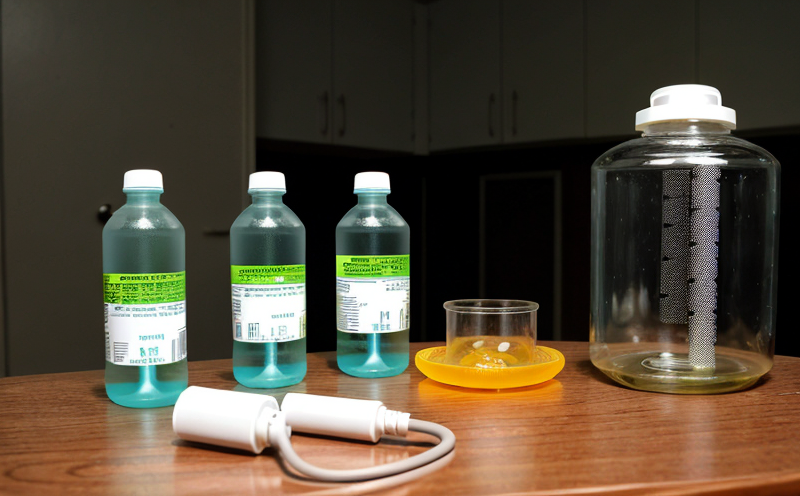ISO 13164-4 Radon in Water Emanation Test
The ISO 13164-4 standard provides a rigorous methodology for measuring radon emanation from water. This test is crucial for ensuring the safety and compliance of water sources, especially those used for drinking or where public health might be at risk. Radon in water can pose significant health risks if not properly managed. By adhering to ISO 13164-4 guidelines, laboratories and testing facilities ensure accurate and reliable results that are internationally recognized.
The process begins with the collection of a representative water sample, which is then prepared according to specific protocols outlined in the standard. The sample must be stored under controlled conditions to prevent any changes in radon levels. Once collected, the water sample is placed into a specially designed container for measurement.
Measurement typically involves placing the water sample within a chamber and applying a standardized procedure to determine the rate of radon emission from the water into the air above it. This process allows for accurate quantification of radon emanation rates, which are then reported in units consistent with international standards. The results are critical not only for regulatory compliance but also for understanding potential health risks associated with radon exposure through drinking water.
It is important to note that the ISO 13164-4 test does more than just measure radon levels; it helps identify potential sources of contamination and ensures that water treatment processes are effective. This testing can be particularly beneficial in areas known for high natural radon concentrations or where there has been a change in local geology.
The accuracy and reliability of ISO 13164-4 results contribute significantly to public health protection, making this test an essential component of any comprehensive water quality assessment. Regulatory bodies often rely on these tests when setting standards for safe drinking water. Compliance with such testing ensures that water suppliers can confidently provide clean, safe water to their customers.
Moreover, the widespread acceptance of ISO 13164-4 across various countries underscores its importance in ensuring consistent and comparable results globally. This consistency is vital given that radon concentration levels may vary significantly depending on geographical location or local geological conditions.
- The standard is widely adopted by regulatory bodies such as the European Union and the US Environmental Protection Agency (EPA).
- It is also recognized by international organizations like the World Health Organization (WHO) for its role in promoting public health through accurate radon measurement techniques.
In summary, the ISO 13164-4 Radon in Water Emanation Test plays a pivotal role in safeguarding public health by providing reliable data on radon emanation rates. Its application is particularly beneficial for water suppliers and regulatory bodies aiming to maintain stringent quality control measures.
Why It Matters
The ISO 13164-4 Radon in Water Emanation Test is crucial because it helps identify radon contamination risks within drinking water supplies. Exposure to high levels of radon can lead to serious health issues, including lung cancer. Ensuring compliance with this standard allows water suppliers and other stakeholders to take proactive measures against potential dangers.
Compliance with ISO 13164-4 is not only a legal requirement but also demonstrates a commitment to maintaining high standards of quality assurance. For regulatory bodies, adherence to these tests ensures that they can enforce safety protocols effectively. Similarly, for water suppliers and R&D engineers involved in developing new purification techniques, accurate measurement through this test provides valuable insights into the performance of their processes.
By integrating ISO 13164-4 into their operations, companies contribute positively to public health by identifying and mitigating risks associated with radon exposure. This proactive approach fosters trust among consumers who rely on safe drinking water as a fundamental necessity.
Benefits
The ISO 13164-4 Radon in Water Emanation Test offers numerous benefits, particularly for entities responsible for managing water resources. One of the key advantages is the ability to detect radon emanations early on, allowing for timely intervention and prevention strategies.
- Enhanced Public Health Protection: By identifying radon levels in drinking water before they become problematic, this test helps safeguard public health by preventing potential exposure risks.
- Regulatory Compliance: Meeting the requirements set forth by ISO 13164-4 ensures that your organization meets all necessary regulatory standards. This can help avoid penalties and legal issues associated with non-compliance.
- Improved Water Quality Assurance: The use of this test enhances overall water quality assurance programs, ensuring that any potential radon contamination is addressed promptly.
In addition to these direct benefits, compliance with ISO 13164-4 also contributes positively to your organization's reputation and credibility. It demonstrates a commitment to excellence in water management practices, which can be particularly advantageous when dealing with stakeholders or customers who prioritize safety and reliability.
International Acceptance and Recognition
The ISO 13164-4 Radon in Water Emanation Test enjoys broad international acceptance due to its robust methodology and consistent results. This recognition is crucial for ensuring that tests conducted by different laboratories around the world are comparable and reliable.
- European Union: The EU has incorporated ISO 13164-4 into its guidelines, emphasizing the importance of this test in maintaining safe drinking water standards across member states.
- United States EPA: The US Environmental Protection Agency also recommends using this standard for radon measurement in water supplies to ensure compliance with health-based benchmarks.
- World Health Organization (WHO): WHO recognizes ISO 13164-4 as a key tool in promoting public health through accurate and consistent measurement of radon levels in drinking water.
- International Atomic Energy Agency (IAEA): The IAEA also supports the use of this standard, highlighting its role in protecting human health from the adverse effects of radon exposure.
The widespread acceptance of ISO 13164-4 ensures that results obtained through this test are universally recognized and can be relied upon for making informed decisions about water quality management. This consistency is especially important given the variability in natural radon concentrations found across different geographical locations.





